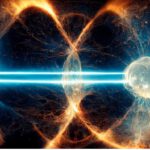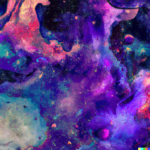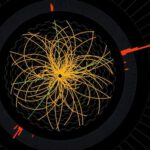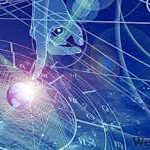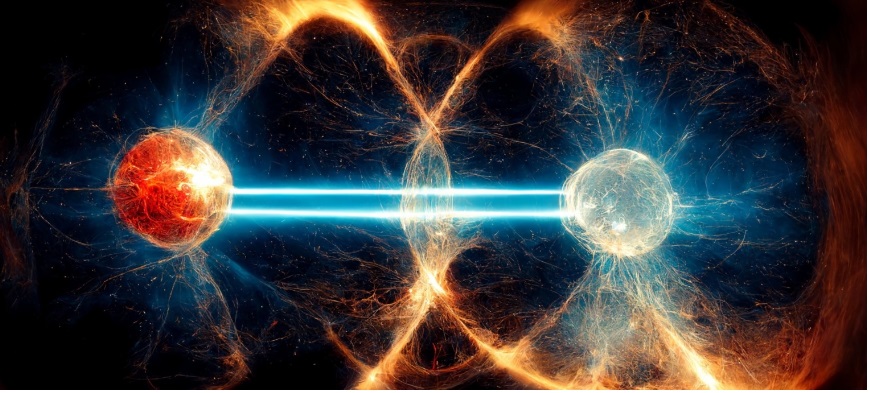The following is the excerpts of a video which relates quantum enganglement with consciousness.
When we dream we feel that the dream is real and suddenly when we wake up we realise that what we saw was not real, but the experience which we had during the dream while we were dreaming was absolutely real. So how do we know what is real and what is not? Scientists define reality as, something is real if its properties are determined prior to being measured. An apple can be green even when no one is looking at it. However, the quantum world seems to be following different rules. Three Scientists have recently won a Nobel Prize proving our universe isn’t locally real. But if our world is real, what is this place we live in?
Imagine there are two people, Anna and Luke, located on opposite sides of our solar system. Two coins are sent from the centre of the solar system, each targeted towards one observer. While the coins are moving through space, they start spinning. According to quantum mechanics, it’s impossible to predict which side the coin will land on. The results are random. When Anna measures heads, she instantly knows Luke’s coin should have landed on tails. The odds of correctly predicting this even 200 times in a row is one in 10 to the 60, which is more than all the atoms in the solar system. Even though Anna and Luke are separated by billions of kilometres, quantum mechanics says Anna can keep predicting Luke’s results based on what she got, as if the coins have a kind of telepathic connection? This thought experiment is known as the Einstein–Podolsky–Rosen paradox. It seems impossible, and yet this is how the universe works. How can something travel faster than light? What is the pixel of our reality, and how does the universe change from predictable to random?
Before quantum mechanics, scientists believed that the world was deterministic. They thought that if they knew certain properties about the physical system, they could determine everything about this system in the past and the future. But then physicists discovered a phenomenon called quantum entanglement. It describes a state in which two particles stay connected regardless of how far apart they are. This may not sound too exciting but imagine this works even if the entangled pair is on opposite sides of the universe. This seems odd even in the world of quantum mechanics.
We generally believe that nothing can travel faster than light, meaning there is a limit to how fast any signal can travel. However, if you create an entangled pair of particles and send them from the opposite direction, increasing the distance between them, and then measure the content state of one particle, the quantum state of the other particle will suddenly be determined. You can imagine it is two boxes, each containing either a white or black stone. So whenever and wherever a person opens one of the boxes, they immediately know the stone in the other box. This has been demonstrated across distances of hundreds of kilometers over time intervals of less than 100 nanoseconds. One nanosecond is equal to one billionth of a second. So, if the two entangled particles somehow exchange information, they do it at speeds at least thousands of times faster than light.
But that’s not all. Just like we stand on scales to measure our weight, scientists measure particles to discover their properties. But what if those properties only became determined the moment you measure them? This would mean our universe couldn’t be both local and real. At least one, if not both, of these premises would be wrong.
Defining reality is a tricky thing to do. We don’t see tiny particles, yet they exist. We cannot touch the air, yet it is there. So, what is real? In physics, real means that objects always have definite properties regardless of whether we are measuring them or not. In other words, a falling fruit from the branch of a tree in a forest makes a sound even if there’s nobody there to hear it, and local means that objects cannot be influenced by their surroundings, and that this influence cannot travel faster than light.
It’s important that our world is real because, as Isaac Newton believed, if you know the positions and velocities of all ingredients of our world and you identify the forces that influence them, physics can predict what the world would be at any time in the future. But the quantum world often has an indeterminate nature. Put simply, it’s often random or cannot be predicted.
Fire number of particles through a narrowly spaced double slit, you can predict what interference pattern will appear on the screen behind the slit, but you will never know where every individual particle will land, even if they are being fired one at a time. Some aspects of quantum physics appear to be completely random, but are they really, random. What if we just lack information?
Albert Einstein believed that entanglement wasn’t violating local realism, but rather that quantum physics was incomplete. He thought that the variables connecting these entangled particles would eventually be found.
The three scientists, Alain Aspect, John Clauser and Anton Zeilinger shared a Nobel Prize for proving these hidden variables don’t exist. The scientists have reached the conclusion that an entangled particle doesn’t have any properties until somebody measures it, and so these properties cannot be known or guessed by any means.
So, if the universe isn’t real, then exactly what are we seeing and experiencing? A group of physicists in Los Angeles have come up with a new theory of reality, and it is based on periodic patterns or crystals. Crystals can be of different shapes, but also of different dimensions, even more so a higher dimensional crystal can be projected to create a pattern in a lower dimension, the resulting pattern is called a quasi-crystal. Physicists took a specific 8D crystal, projected it to 4D at a certain angle, from it they have driven a 3D quasi-crystal which they believe is a substructure of all reality. The fundamental building 3D quasi-crystal is called a tetrahedron or a 3-dimensional triangle with all sides of the same length, and this length is the smallest theorized unit of length in existence called the plank length, which is 10 to the -20 times the size of a proton. If an atom were the size of the Earth, it would be about the size of a proton. This is where it gets spooky. According to their theory, just like digital displays consist of the smallest units of a digital image, pixels, a tetrahedral is the 3D pixel of our reality. Each tetrahedron has just a few states in which it can exist, and the state of one tetrahedron, defines the state of other tetrahedrons that fill the entire space of the universe. But if a tetrahedron can only be one specific state in the given moment, who or what dictates the state it should be in? Physicists all across the globe believe that reality is made of information, but what is information? Information is meaning expressed through symbols. But meaning is nothing else but comparison or an ability to perceive something relative to something else. And if so, comparison and meaning require choice. In other words, consciousness.
So just like when we know what the properties of an entangled particle are when we measure them, meaning of information can only exist when it’s perceived or measured. If all this is true, reality could be a product of consciousness.
So, we can conclude, that our reality is just consciousness expressed in a quantum field. I would like to believe that this conscousness which projects itself as the universe in the quantum space is what we can call the super consciousness or God or Highest Energy etc and we are part of this quantum field expereincing this universe.
If we accept this as our reality, consciousness obtained is for a clear purpose. It’s an integrated subjective interface that consists of 5 senses. No natural laws, philosophical or scientific ideas predict the emergence of consciousness, and there is no player utility or evolutionary advantage provided. So, it seems its primary function is for us to experience it.

